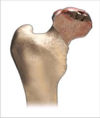Orthopaedic Hip Conditions Flashcards
(51 cards)
what are some common conditions of the hip?
Osteoarthritis
Bursitis (causes lateral hip pain) - Gluteal tendinopathy (differential diagnosis)
Avascular Necrosis (AVN)
Impingement
Labral Tear
what make sup the pelvis?
Each hemipelvis = fusion of 3 bones (Ischium, Ileum and Pubis)
joined by Sacrum posteriorly and pubic symphysis anteriorly
Acetabulum - Socket

Femur is long bone, what is its high clinical significance?
NoF
Bleeding
what are the different parts of the femur and their function?
Head - Articulates with Acetabulum, Head covered in smooth hyaline cartilage and if damaged wont regenerate and beginning of arthritis
Neck - Blood supply
Greater Trochanter - Attachment for Abductors and Rotators (external)
Lesser trochanter - Attachment for Psoas

what is the acetabulum?
Part of Pelvis
Cup-shape socket
Ligamentum teres in middle

what is the labrum and its function?
Fibrocartilagious lining of acetabulum
Deepen socket
Add stability

what is the blood supply?
Profunda femoris (branch of femoral)
Branches medial and lateral circumflex arteries
MFCA (Major contributor to femoral head) - 2 branches - Ascend to head and Transverse to form cruciate anastomosis
LFCA (lateral femoral circumflex artery) - 3 branches - Ascending branch to joint capsule, Transverse branch to cruciate anastomosis, Descending branch

hwat are other minor contributors to the blood supply?
Artery of Ligamentum Teres
Nutrient Arteries of Bone (vessels in the femur so when fractured blood supply to head is disrupted
where does the blood supply to the neck of the femur enter and what is its clinical significance?
Neck Of Femur - Primary blood supply enters via Capsule
Clinical Significance - Fracture Neck of Femur
Intracapsular Fracture = Blood supply disrupted
Extracapsular Fracture = Blood supply maintained
Anastomosis on the neck of femur and ascend to the head
Fractures out of the capsule don’t have risk of avascular necrosis

13 muscles around the hip joint which do what actions?
Flexors
Extensors
Abductors
Adductors
Rotators

what are bursae?
Fluid-filled sacs
Reduce friction between tissues
what is osteoarthritis?
Degenerative change of synovial joints
Progressive loss of articular cartilage
Secondary bony changes
Can be primary or secondary (a pathology that’s caused damage)
Hip replacement is main treatment for people with bad arthritis

how does osteoarthritis present?
Characterised by worsening pain and stiffness of the affected joint
Limiting everyday life
what is Trochanteric Bursitis?
Trochanteric Bursa is a Fluid-filled sac that is Sandwiched between hip abductors and ITB
Bursitis - Inflammation of the bursa, Swelling
Epidemiology - Females > Males

what are the causes of trochanteric bursitis?
Trauma
Over-use - Athletes, often runners, Repetitive movements
Abnormal movements:
- Distant problem, e.g. Scoliosis
- Local problem - Muscle wasting following surgery (so have to tense harder), Total Hip Replacement, Osteoarthritis

what is the presentation of trochanteric bursitis?
Pain (well localised)
Point tenderness
Lateral hip
what would be found on examination of trochanteric bursitis?
LOOK:
- May have scars from previous surgery
- May have muscle wasting - Gluteals
FEEL:
- Tenderness at Greater Tuberosity
MOVE:
- Worst pain in active abduction
how do you investigate trochanteric bursitis?
X-ray - May be normal, OA, THR, Spine abnormalities
MRI - Shows soft tissues and fluid
Ultrasound - Can be therapeutic as well as diagnostic, Guided injection

what is the treatment of trochanteric bursitis?
NSAIDs
Relative rest / Activity modification
Physiotherapy:
- Correct posture, abnormal movements
- Stretching
- Strengthen muscles around joint
Injection - Corticosteroids
Surgery - Bursectomy (leaves scar which may be painful and not helpful, divide ITB aswell), Rarely required
what is avascular necrosis?
Death of bone due to loss of blood supply
onset of hip pain

what is the epidemiology of avascular necrosis?
Males > Females
Average age 35-50 years old
80% = bilateral (May be offset in time)
3% = multifocal (3 or more joints)
what are the risk factos for avascular necrosis? (trauma)
Irradiation
Fracture
Dislocation
Iatrogenic

what are the risk factos for avascular necrosis? (systemic)
Idiopathic
Hypercoaguable states
Steroids
Haematological - Sickle Cell Disease, Lymphoma, Leukaemia
Caisson’s disease (divers)
Alcoholism (commonest risk factor)
avascular necrosis can be caused by trauma to what area?
Injury to femoral head blood supply
Intracapsular fracture
Anastomosis of blood vessels around neck of femur















